Software Engineering: Project Failures, Models, and Analysis
VerifiedAdded on 2023/06/08
|8
|1830
|208
Homework Assignment
AI Summary
This assignment delves into the critical aspects of software engineering, focusing on project failures and software development methodologies. It begins by defining software project failure and provides two detailed case studies: the Hewlett-Packard (HP) ERP migration failure and the Sydney Water Corporation (SWC) billing system failure. The analysis of these failures highlights communication problems, data integration issues, and lack of experience as key contributing factors. The assignment then explores the Waterfall model, describing its phases, advantages, and when it is most appropriate for use. It discusses the implications of requirement changes within the Waterfall model. Furthermore, it contrasts the Waterfall model with incremental delivery, outlining the advantages of the latter, such as rapid software production and flexibility in adapting to changing requirements. The assignment concludes by presenting an example where the Waterfall model is inappropriate, emphasizing its limitations for larger, complex projects.
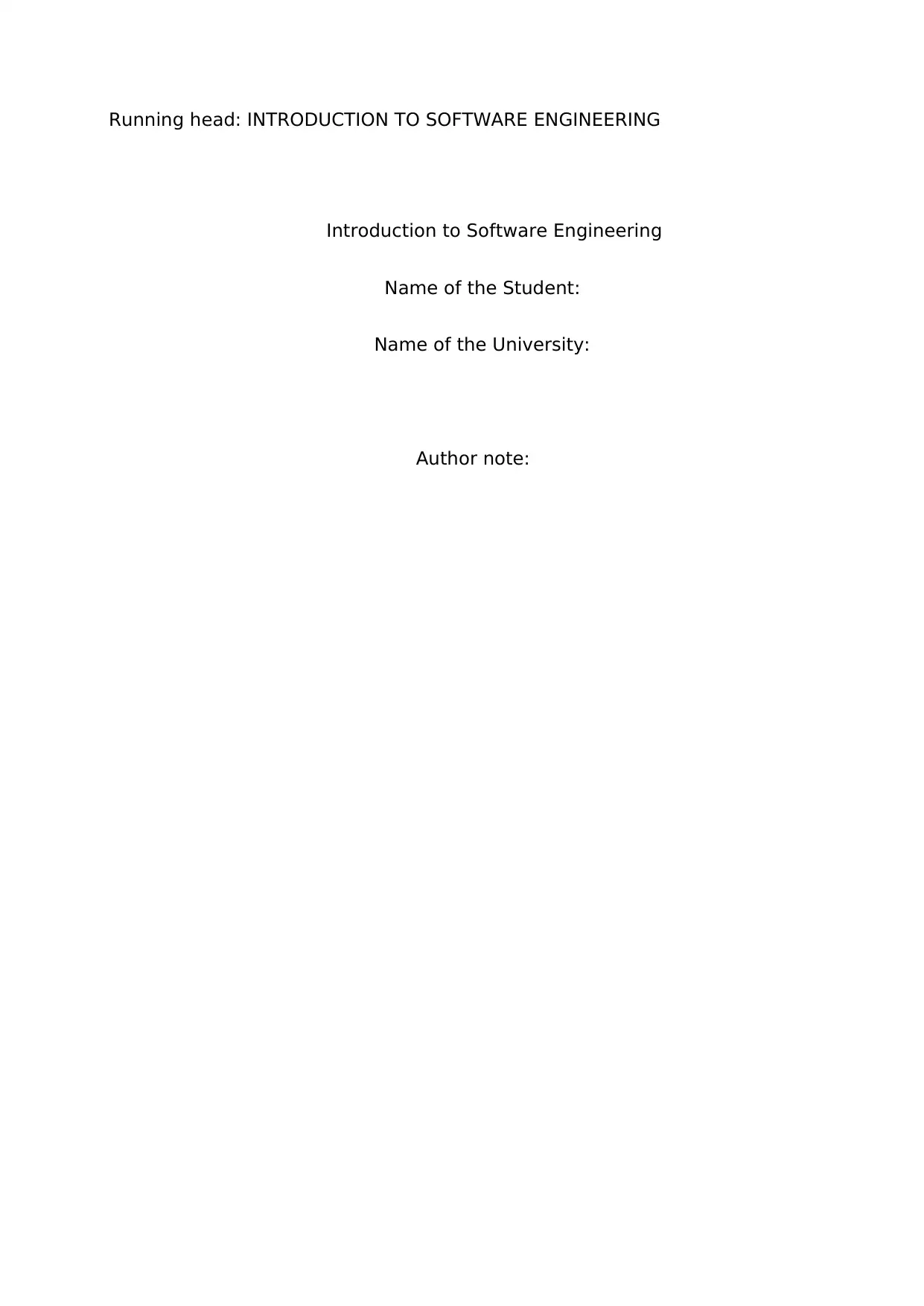
Running head: INTRODUCTION TO SOFTWARE ENGINEERING
Introduction to Software Engineering
Name of the Student:
Name of the University:
Author note:
Introduction to Software Engineering
Name of the Student:
Name of the University:
Author note:
Paraphrase This Document
Need a fresh take? Get an instant paraphrase of this document with our AI Paraphraser
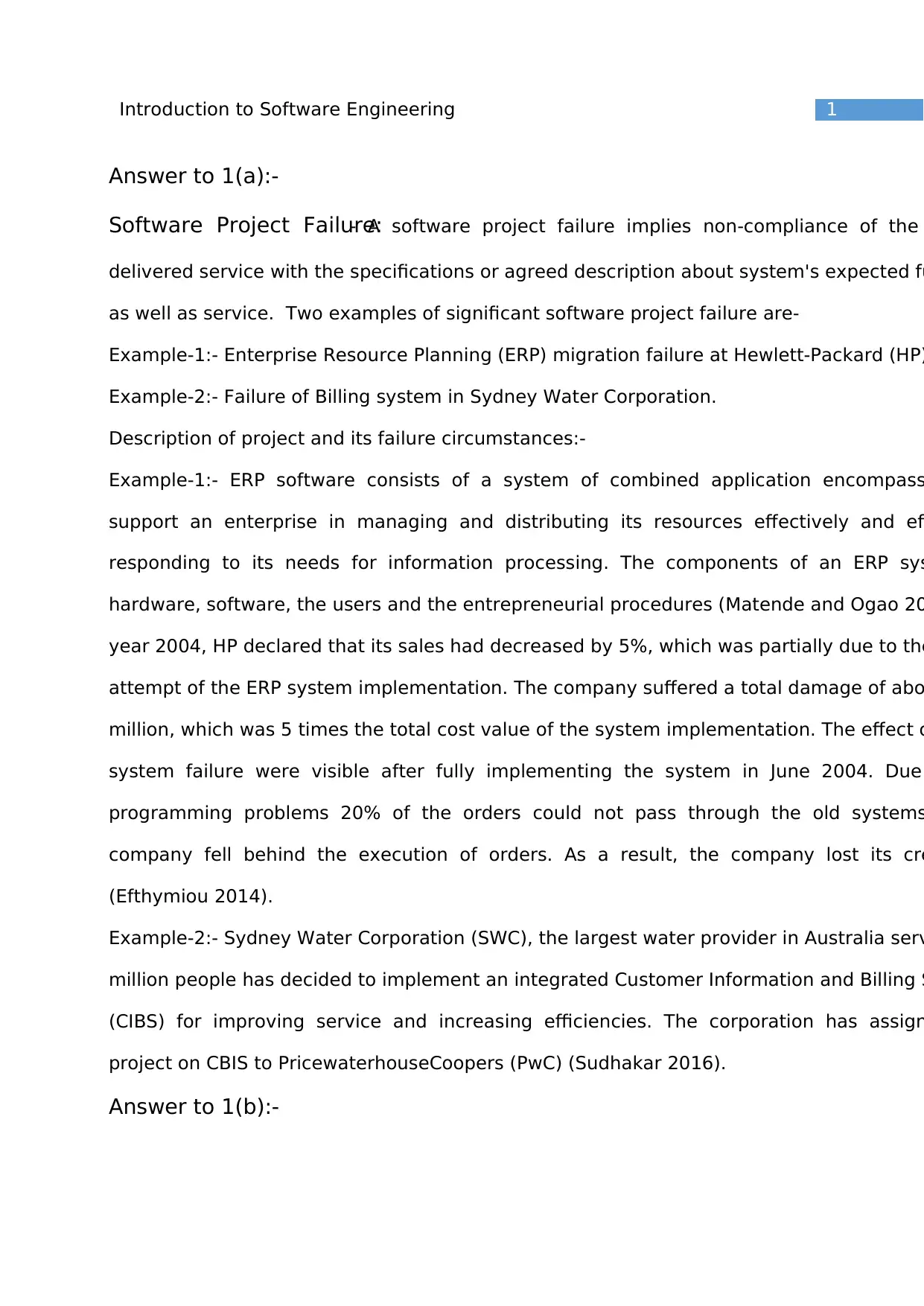
1Introduction to Software Engineering
Answer to 1(a):-
Software Project Failure:- A software project failure implies non-compliance of the
delivered service with the specifications or agreed description about system's expected fu
as well as service. Two examples of significant software project failure are-
Example-1:- Enterprise Resource Planning (ERP) migration failure at Hewlett-Packard (HP)
Example-2:- Failure of Billing system in Sydney Water Corporation.
Description of project and its failure circumstances:-
Example-1:- ERP software consists of a system of combined application encompass
support an enterprise in managing and distributing its resources effectively and effi
responding to its needs for information processing. The components of an ERP sys
hardware, software, the users and the entrepreneurial procedures (Matende and Ogao 20
year 2004, HP declared that its sales had decreased by 5%, which was partially due to the
attempt of the ERP system implementation. The company suffered a total damage of abo
million, which was 5 times the total cost value of the system implementation. The effect o
system failure were visible after fully implementing the system in June 2004. Due
programming problems 20% of the orders could not pass through the old systems
company fell behind the execution of orders. As a result, the company lost its cre
(Efthymiou 2014).
Example-2:- Sydney Water Corporation (SWC), the largest water provider in Australia serv
million people has decided to implement an integrated Customer Information and Billing S
(CIBS) for improving service and increasing efficiencies. The corporation has assign
project on CBIS to PricewaterhouseCoopers (PwC) (Sudhakar 2016).
Answer to 1(b):-
Answer to 1(a):-
Software Project Failure:- A software project failure implies non-compliance of the
delivered service with the specifications or agreed description about system's expected fu
as well as service. Two examples of significant software project failure are-
Example-1:- Enterprise Resource Planning (ERP) migration failure at Hewlett-Packard (HP)
Example-2:- Failure of Billing system in Sydney Water Corporation.
Description of project and its failure circumstances:-
Example-1:- ERP software consists of a system of combined application encompass
support an enterprise in managing and distributing its resources effectively and effi
responding to its needs for information processing. The components of an ERP sys
hardware, software, the users and the entrepreneurial procedures (Matende and Ogao 20
year 2004, HP declared that its sales had decreased by 5%, which was partially due to the
attempt of the ERP system implementation. The company suffered a total damage of abo
million, which was 5 times the total cost value of the system implementation. The effect o
system failure were visible after fully implementing the system in June 2004. Due
programming problems 20% of the orders could not pass through the old systems
company fell behind the execution of orders. As a result, the company lost its cre
(Efthymiou 2014).
Example-2:- Sydney Water Corporation (SWC), the largest water provider in Australia serv
million people has decided to implement an integrated Customer Information and Billing S
(CIBS) for improving service and increasing efficiencies. The corporation has assign
project on CBIS to PricewaterhouseCoopers (PwC) (Sudhakar 2016).
Answer to 1(b):-

2Introduction to Software Engineering
Major reasons of project failure:-They are as follows.
Example-1:-
There were communication problems between the various groups. For instance,
proper communication maintenance between order-taking group at front end and
group at back-end.
The data integration problem occurred due to ineffective product training and inapprop
product data management.
The system testing has been conducted only on the basis of standardized orders and it
not sufficiently tested for customized order (Dwivedi et al. 2015).
The information technology (IT) personnel were not provided sufficient time to build th
skills for new system and forced to use the new technology.
Example-2:- After formation of SWC’s information technology (IT) department in 20
reviewed the documents of CIBS architecture and advised PwC that the software failed 19
20 requirements (Beal and Flynn 2014). The reason for this is are follows.
There is communication breakdown due to conflict between SWC’s IT department and
Inexperience in Sydney Water’s project team as well as inexperienced in systems integ
by PwC team. Moreover, the project team was working at too low a level.
A lack of high-level representation from legal and corporate finance.
Answer to 2(a):-
Waterfall Model:-
Description of phases of the waterfall model:- The phases can be described as follows.
Major reasons of project failure:-They are as follows.
Example-1:-
There were communication problems between the various groups. For instance,
proper communication maintenance between order-taking group at front end and
group at back-end.
The data integration problem occurred due to ineffective product training and inapprop
product data management.
The system testing has been conducted only on the basis of standardized orders and it
not sufficiently tested for customized order (Dwivedi et al. 2015).
The information technology (IT) personnel were not provided sufficient time to build th
skills for new system and forced to use the new technology.
Example-2:- After formation of SWC’s information technology (IT) department in 20
reviewed the documents of CIBS architecture and advised PwC that the software failed 19
20 requirements (Beal and Flynn 2014). The reason for this is are follows.
There is communication breakdown due to conflict between SWC’s IT department and
Inexperience in Sydney Water’s project team as well as inexperienced in systems integ
by PwC team. Moreover, the project team was working at too low a level.
A lack of high-level representation from legal and corporate finance.
Answer to 2(a):-
Waterfall Model:-
Description of phases of the waterfall model:- The phases can be described as follows.
⊘ This is a preview!⊘
Do you want full access?
Subscribe today to unlock all pages.

Trusted by 1+ million students worldwide
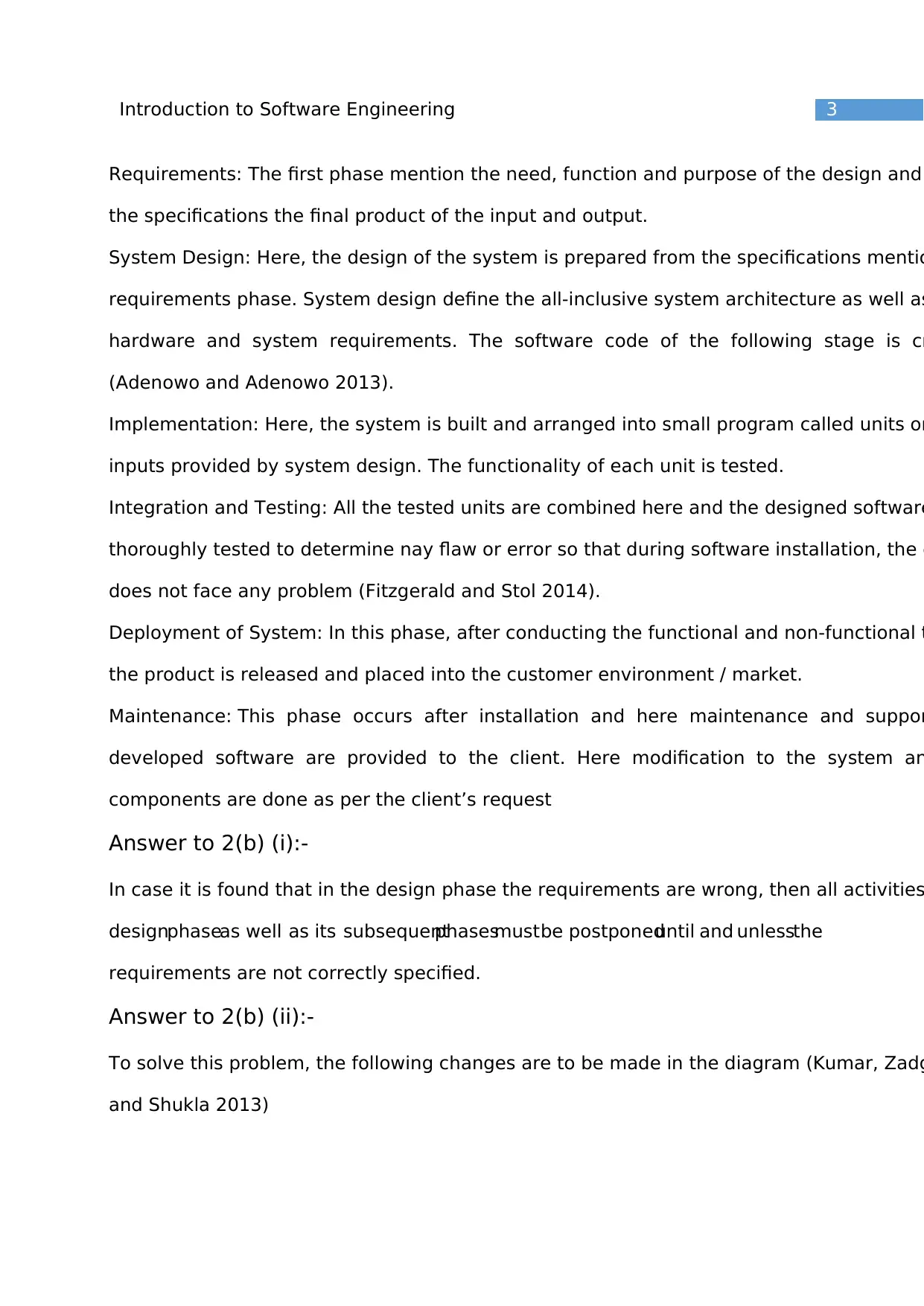
3Introduction to Software Engineering
Requirements: The first phase mention the need, function and purpose of the design and
the specifications the final product of the input and output.
System Design: Here, the design of the system is prepared from the specifications mentio
requirements phase. System design define the all-inclusive system architecture as well as
hardware and system requirements. The software code of the following stage is cr
(Adenowo and Adenowo 2013).
Implementation: Here, the system is built and arranged into small program called units on
inputs provided by system design. The functionality of each unit is tested.
Integration and Testing: All the tested units are combined here and the designed software
thoroughly tested to determine nay flaw or error so that during software installation, the c
does not face any problem (Fitzgerald and Stol 2014).
Deployment of System: In this phase, after conducting the functional and non-functional t
the product is released and placed into the customer environment / market.
Maintenance: This phase occurs after installation and here maintenance and suppor
developed software are provided to the client. Here modification to the system an
components are done as per the client’s request
Answer to 2(b) (i):-
In case it is found that in the design phase the requirements are wrong, then all activities
designphaseas well as its subsequentphasesmust be postponeduntil and unlessthe
requirements are not correctly specified.
Answer to 2(b) (ii):-
To solve this problem, the following changes are to be made in the diagram (Kumar, Zadg
and Shukla 2013)
Requirements: The first phase mention the need, function and purpose of the design and
the specifications the final product of the input and output.
System Design: Here, the design of the system is prepared from the specifications mentio
requirements phase. System design define the all-inclusive system architecture as well as
hardware and system requirements. The software code of the following stage is cr
(Adenowo and Adenowo 2013).
Implementation: Here, the system is built and arranged into small program called units on
inputs provided by system design. The functionality of each unit is tested.
Integration and Testing: All the tested units are combined here and the designed software
thoroughly tested to determine nay flaw or error so that during software installation, the c
does not face any problem (Fitzgerald and Stol 2014).
Deployment of System: In this phase, after conducting the functional and non-functional t
the product is released and placed into the customer environment / market.
Maintenance: This phase occurs after installation and here maintenance and suppor
developed software are provided to the client. Here modification to the system an
components are done as per the client’s request
Answer to 2(b) (i):-
In case it is found that in the design phase the requirements are wrong, then all activities
designphaseas well as its subsequentphasesmust be postponeduntil and unlessthe
requirements are not correctly specified.
Answer to 2(b) (ii):-
To solve this problem, the following changes are to be made in the diagram (Kumar, Zadg
and Shukla 2013)
Paraphrase This Document
Need a fresh take? Get an instant paraphrase of this document with our AI Paraphraser

4Introduction to Software Engineering
The process must be defined clearly for receiving as well as analysing and incl
changed requests and make the customer aware of his/her entry point into the proces
The target for each development phase must be set to a certain point beyond
changes are not allowable.
The changed requests should be properly as well as clearly communicated to all stake
and accordingly after that the master project plan is updated.
Answer to 2(c):-
Advantages of waterfall model:-They are as follows.
This model is simple to understand and easy to use.
Due to its rigidity, the waterfall model is managed easily as each phase consists of a re
process along with fixed deliverables.
In this model, phases do not overlap as each phase are processed and comple
time.
Waterfallmodel works well for smallerprojectswhererequirementsare very well
understood.
When to use the waterfall model:
The model should be used particularly in short project with the following features.
The requirements must be fixed, unambiguous and clear which means that product de
is fixed and technology is understood.
There is free availability of ample resources with required expertise.
There is nominal customer interaction during the product development of the product.
There is free availability of ample resources with required expertise.
The process must be defined clearly for receiving as well as analysing and incl
changed requests and make the customer aware of his/her entry point into the proces
The target for each development phase must be set to a certain point beyond
changes are not allowable.
The changed requests should be properly as well as clearly communicated to all stake
and accordingly after that the master project plan is updated.
Answer to 2(c):-
Advantages of waterfall model:-They are as follows.
This model is simple to understand and easy to use.
Due to its rigidity, the waterfall model is managed easily as each phase consists of a re
process along with fixed deliverables.
In this model, phases do not overlap as each phase are processed and comple
time.
Waterfallmodel works well for smallerprojectswhererequirementsare very well
understood.
When to use the waterfall model:
The model should be used particularly in short project with the following features.
The requirements must be fixed, unambiguous and clear which means that product de
is fixed and technology is understood.
There is free availability of ample resources with required expertise.
There is nominal customer interaction during the product development of the product.
There is free availability of ample resources with required expertise.
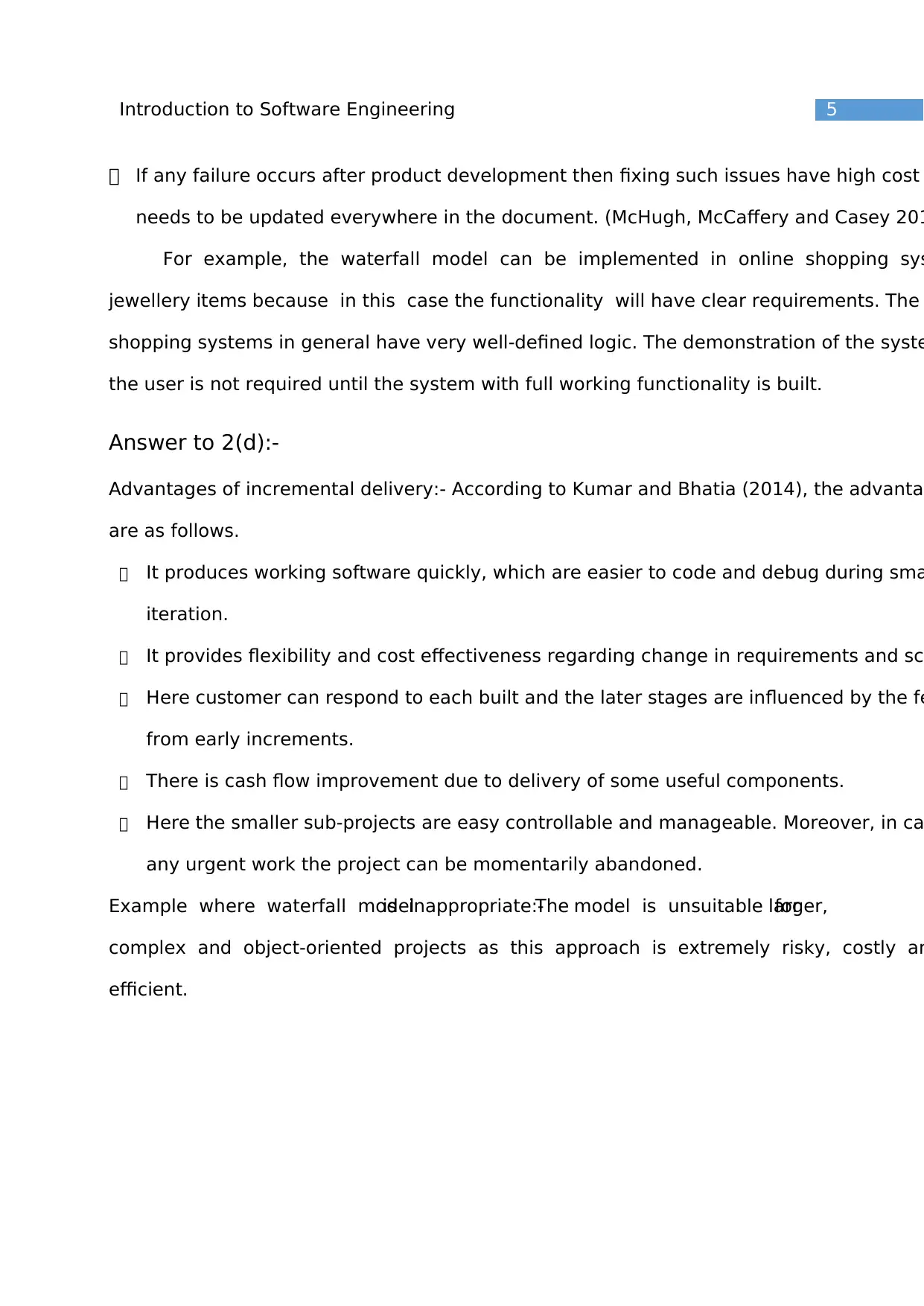
5Introduction to Software Engineering
If any failure occurs after product development then fixing such issues have high cost
needs to be updated everywhere in the document. (McHugh, McCaffery and Casey 201
For example, the waterfall model can be implemented in online shopping sys
jewellery items because in this case the functionality will have clear requirements. The
shopping systems in general have very well-defined logic. The demonstration of the syste
the user is not required until the system with full working functionality is built.
Answer to 2(d):-
Advantages of incremental delivery:- According to Kumar and Bhatia (2014), the advanta
are as follows.
It produces working software quickly, which are easier to code and debug during sma
iteration.
It provides flexibility and cost effectiveness regarding change in requirements and sc
Here customer can respond to each built and the later stages are influenced by the fe
from early increments.
There is cash flow improvement due to delivery of some useful components.
Here the smaller sub-projects are easy controllable and manageable. Moreover, in ca
any urgent work the project can be momentarily abandoned.
Example where waterfall modelis inappropriate:-The model is unsuitable forlarger,
complex and object-oriented projects as this approach is extremely risky, costly an
efficient.
If any failure occurs after product development then fixing such issues have high cost
needs to be updated everywhere in the document. (McHugh, McCaffery and Casey 201
For example, the waterfall model can be implemented in online shopping sys
jewellery items because in this case the functionality will have clear requirements. The
shopping systems in general have very well-defined logic. The demonstration of the syste
the user is not required until the system with full working functionality is built.
Answer to 2(d):-
Advantages of incremental delivery:- According to Kumar and Bhatia (2014), the advanta
are as follows.
It produces working software quickly, which are easier to code and debug during sma
iteration.
It provides flexibility and cost effectiveness regarding change in requirements and sc
Here customer can respond to each built and the later stages are influenced by the fe
from early increments.
There is cash flow improvement due to delivery of some useful components.
Here the smaller sub-projects are easy controllable and manageable. Moreover, in ca
any urgent work the project can be momentarily abandoned.
Example where waterfall modelis inappropriate:-The model is unsuitable forlarger,
complex and object-oriented projects as this approach is extremely risky, costly an
efficient.
⊘ This is a preview!⊘
Do you want full access?
Subscribe today to unlock all pages.

Trusted by 1+ million students worldwide
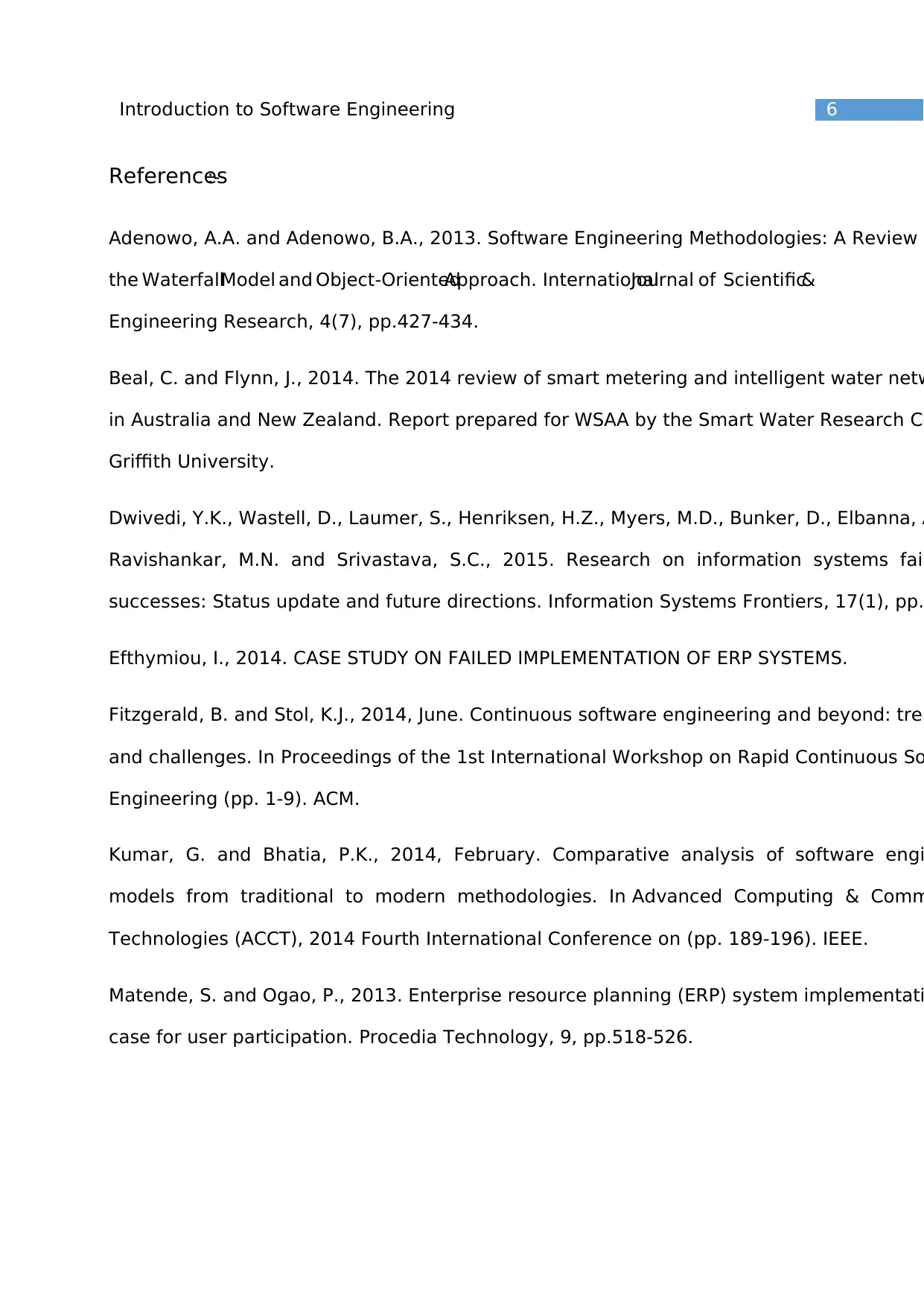
6Introduction to Software Engineering
References:-
Adenowo, A.A. and Adenowo, B.A., 2013. Software Engineering Methodologies: A Review
the WaterfallModel and Object-OrientedApproach. InternationalJournal of Scientific&
Engineering Research, 4(7), pp.427-434.
Beal, C. and Flynn, J., 2014. The 2014 review of smart metering and intelligent water netw
in Australia and New Zealand. Report prepared for WSAA by the Smart Water Research Ce
Griffith University.
Dwivedi, Y.K., Wastell, D., Laumer, S., Henriksen, H.Z., Myers, M.D., Bunker, D., Elbanna, A
Ravishankar, M.N. and Srivastava, S.C., 2015. Research on information systems fail
successes: Status update and future directions. Information Systems Frontiers, 17(1), pp.
Efthymiou, I., 2014. CASE STUDY ON FAILED IMPLEMENTATION OF ERP SYSTEMS.
Fitzgerald, B. and Stol, K.J., 2014, June. Continuous software engineering and beyond: tren
and challenges. In Proceedings of the 1st International Workshop on Rapid Continuous So
Engineering (pp. 1-9). ACM.
Kumar, G. and Bhatia, P.K., 2014, February. Comparative analysis of software engi
models from traditional to modern methodologies. In Advanced Computing & Comm
Technologies (ACCT), 2014 Fourth International Conference on (pp. 189-196). IEEE.
Matende, S. and Ogao, P., 2013. Enterprise resource planning (ERP) system implementati
case for user participation. Procedia Technology, 9, pp.518-526.
References:-
Adenowo, A.A. and Adenowo, B.A., 2013. Software Engineering Methodologies: A Review
the WaterfallModel and Object-OrientedApproach. InternationalJournal of Scientific&
Engineering Research, 4(7), pp.427-434.
Beal, C. and Flynn, J., 2014. The 2014 review of smart metering and intelligent water netw
in Australia and New Zealand. Report prepared for WSAA by the Smart Water Research Ce
Griffith University.
Dwivedi, Y.K., Wastell, D., Laumer, S., Henriksen, H.Z., Myers, M.D., Bunker, D., Elbanna, A
Ravishankar, M.N. and Srivastava, S.C., 2015. Research on information systems fail
successes: Status update and future directions. Information Systems Frontiers, 17(1), pp.
Efthymiou, I., 2014. CASE STUDY ON FAILED IMPLEMENTATION OF ERP SYSTEMS.
Fitzgerald, B. and Stol, K.J., 2014, June. Continuous software engineering and beyond: tren
and challenges. In Proceedings of the 1st International Workshop on Rapid Continuous So
Engineering (pp. 1-9). ACM.
Kumar, G. and Bhatia, P.K., 2014, February. Comparative analysis of software engi
models from traditional to modern methodologies. In Advanced Computing & Comm
Technologies (ACCT), 2014 Fourth International Conference on (pp. 189-196). IEEE.
Matende, S. and Ogao, P., 2013. Enterprise resource planning (ERP) system implementati
case for user participation. Procedia Technology, 9, pp.518-526.
Paraphrase This Document
Need a fresh take? Get an instant paraphrase of this document with our AI Paraphraser
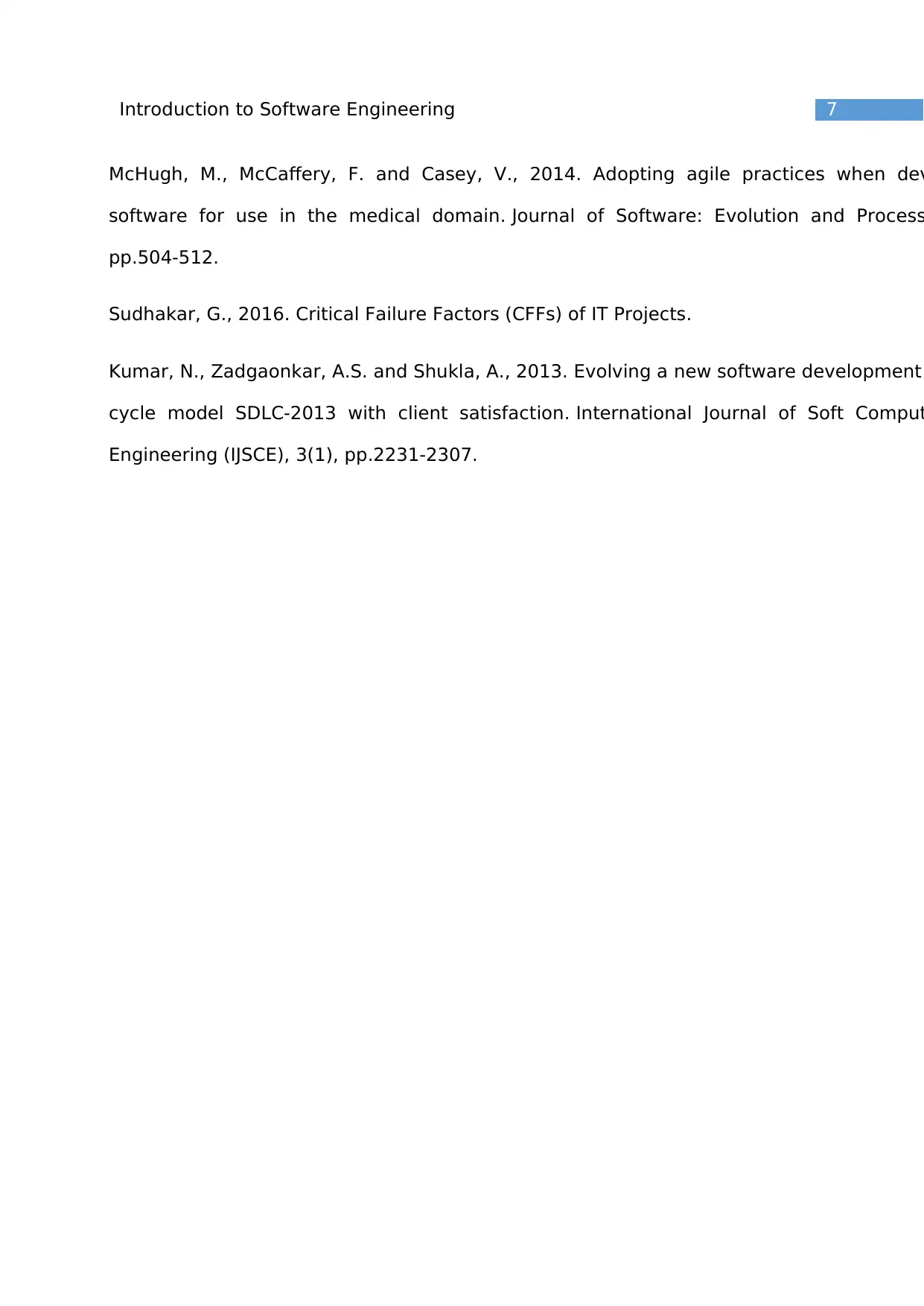
7Introduction to Software Engineering
McHugh, M., McCaffery, F. and Casey, V., 2014. Adopting agile practices when dev
software for use in the medical domain. Journal of Software: Evolution and Process
pp.504-512.
Sudhakar, G., 2016. Critical Failure Factors (CFFs) of IT Projects.
Kumar, N., Zadgaonkar, A.S. and Shukla, A., 2013. Evolving a new software development
cycle model SDLC-2013 with client satisfaction. International Journal of Soft Comput
Engineering (IJSCE), 3(1), pp.2231-2307.
McHugh, M., McCaffery, F. and Casey, V., 2014. Adopting agile practices when dev
software for use in the medical domain. Journal of Software: Evolution and Process
pp.504-512.
Sudhakar, G., 2016. Critical Failure Factors (CFFs) of IT Projects.
Kumar, N., Zadgaonkar, A.S. and Shukla, A., 2013. Evolving a new software development
cycle model SDLC-2013 with client satisfaction. International Journal of Soft Comput
Engineering (IJSCE), 3(1), pp.2231-2307.
1 out of 8
Your All-in-One AI-Powered Toolkit for Academic Success.
+13062052269
info@desklib.com
Available 24*7 on WhatsApp / Email
![[object Object]](/_next/static/media/star-bottom.7253800d.svg)
Unlock your academic potential
Copyright © 2020–2025 A2Z Services. All Rights Reserved. Developed and managed by ZUCOL.


